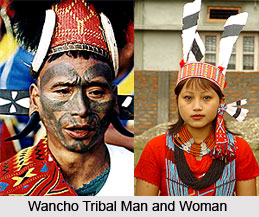 The Wanchos were known as the Nagas of the east or the Banferia Nagas during the pre-Independent period and at the time of the British Administration. During the days of the Ahom king they were called Bar-Mithunias, Haru Mithunias, Banferias, Bar-Banchang, Haru Banchang and so on. The name of the tribe Wancho became widely accepted after the administration of the area was taken over by the Indian Government post Independence. The Wanchos were commonly known as head-hunters. The Wanchos came to be recognized after the massacre of the Survey Party which was led by Captain Badgley and Lieutenant Holcomb, in the Wancho village of Nino, more than a century ago. During various developmental programmes by the Government the tribe came into light.
The Wanchos were known as the Nagas of the east or the Banferia Nagas during the pre-Independent period and at the time of the British Administration. During the days of the Ahom king they were called Bar-Mithunias, Haru Mithunias, Banferias, Bar-Banchang, Haru Banchang and so on. The name of the tribe Wancho became widely accepted after the administration of the area was taken over by the Indian Government post Independence. The Wanchos were commonly known as head-hunters. The Wanchos came to be recognized after the massacre of the Survey Party which was led by Captain Badgley and Lieutenant Holcomb, in the Wancho village of Nino, more than a century ago. During various developmental programmes by the Government the tribe came into light.
There is no documentation about the migration of the tribe in their current location. The oral tradition of the people have marked their presence even prior to the Ahom`s occupation of Assam in early years of the thirteenth century A.D. (1828). Their contact with the plains during the Ahom period is available in some of the histories and chronicles in its modest form. Rather more detailed information is accessible only from the beginning of the British rule in this part of the country. Even Dalton referred them in the general term "Eastern Nagas". Relevant information about the Wancho tribe is available from the post British period. Wanchos in the foothill areas close to the Assam border maintained a close association with the plains. These people served to maintain contacts for the people living in the interior and border areas.
According to the myths the Wanchos migrated to their present habitat from a place called Nyannu, situated towards the south-west beyond the Patkai Hills or Purvanchal Ranges. From Nyannu they travelled to their current habitation via Tangnu and Changu, two villages in Tuensang district of Nagaland. Those who came via Tangnu are called Tangjan and the others who came via Changnu are called Changjan. These two are the main divisions of the Wanchos.
The Wanchos have had very friendly relations with the residents of the plains of Assam.
Although few recorded incidents reveal that the Wanchos on many occasions came into conflicts with the Ahoms yet such memories were transitory. British period reports have categorised the Wanchos under the Eastern Naga group and have marked them to be fierce and uncivilized. The other names of the groups that have been occasionally mentioned are the Banferia, Mutons, Jaboka, Bormithun, Haru-Mithun.
The total population of the Wancho tribes are uncertain. The first British officer, Captain Brodie to travel in their areas devised the rule of paying an annual tribute, as a token of their submission to the British government. Given that, the policy of active control was practised and troops were deployed to enforce law and order in the Wancho area. Later the policy of `non-interference` was adopted as the earlier policy went defective. Frequent visit was then discouraged. This policy prevented fueds. During the Ahom and the British period there were frequent inter-village raids and disputes among the Wanchos. Nevertheless, the situation improved since the administration of the area was taken over by the Government of India.
















